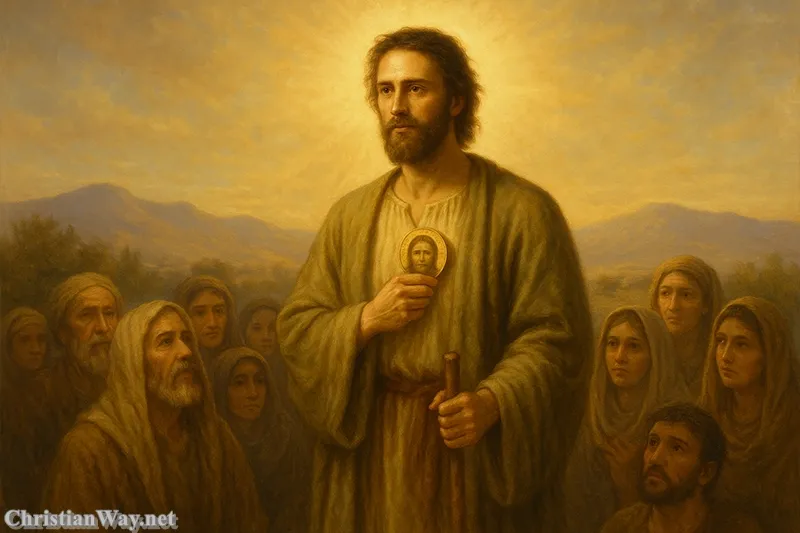Dear friends in Christ,
Every heart that has ever loved deeply knows something of Saint John. He was the disciple who leaned upon the heart of Christ, who heard the beat of divine love from within the mystery of the Incarnate Word. Among the Twelve, he stands as a figure of intimacy, tenderness, and profound faith — the one whom Jesus loved, who never left His side even at the Cross, and who became the first theologian of love.
To speak of Saint John the Apostle, also called John the Evangelist, is to speak of the heart of the Gospel itself. His life, writings, and witness form a bridge between heaven and earth — a testimony that “God is love” (1 John 4:8). In his Gospel, we are not only told about Christ; we are invited to encounter Him, to “see His glory, the glory as of the only Son from the Father, full of grace and truth” (John 1:14).

Let us, then, walk gently through the life and faith of Apostle John, the Beloved Disciple, whose voice still calls the Church to the depths of divine intimacy.
The Young Fisherman Whom Jesus Called
In the early days of Galilee, John was a fisherman, the son of Zebedee and Salome, and the younger brother of Saint James the Greater. Alongside Peter and Andrew, the brothers James and John worked the waters of the Sea of Galilee. But one day, a Man appeared upon the shore — and everything changed.
“Jesus saw two brothers, James the son of Zebedee and John his brother, in the boat with Zebedee their father, mending their nets, and He called them. Immediately they left the boat and their father and followed Him” (Matthew 4:21–22).
The immediacy of their response reveals the fire already burning in their hearts. The call of Jesus cut through the ordinary rhythms of life. John left behind his nets, his father, and his livelihood, to follow the One he would one day call the Word made flesh.
The Son of Thunder and the Beloved Disciple
Jesus gave James and John a name: Boanerges, “sons of thunder” (Mark 3:17). It was not a compliment to their tempers but a prophecy of the passion that burned within them — a zeal that would, in time, be purified by love.
There was a moment when John asked if he should call down fire from heaven upon those who rejected Jesus (Luke 9:54). Later, that same heart would be capable of writing, “Beloved, let us love one another, for love is from God” (1 John 4:7). Such transformation shows us what grace can do — it can turn thunder into tenderness, zeal into charity, power into peace.
To become the Beloved Disciple was not a privilege of favoritism, but a fruit of conversion. John allowed himself to be loved by Christ and, through that love, became capable of loving others in return.
The Apostle Closest to the Heart of Jesus
On the night of the Last Supper, when all the Apostles reclined around the table, John took the place nearest to Jesus. The Gospel tells us: “One of His disciples, whom Jesus loved, was lying close to the breast of Jesus” (John 13:23).
That closeness is symbolic. John, resting his head near the Sacred Heart, represents the soul that abides in Christ, that listens for the heartbeat of divine mercy. In that moment, he heard the rhythm of eternal love — the same love that would later be poured out on the Cross.
When others fled, John remained. Standing at the foot of the Cross, he witnessed love unto death. Christ looked down and saw His mother and the disciple He loved. And He said, “Behold your mother” (John 19:27). From that hour, John took Mary into his home — and into his heart.
That scene is not just a personal moment between Jesus and John; it is a moment of birth for the Church. John stands as a representative of all disciples, receiving Mary as mother. The Beloved Disciple thus becomes the first child of the Church, born at the foot of the Cross.
The Evangelist of Divine Love
After the Resurrection, John became a living witness to Christ’s glory. While Peter became the leader and preacher, John became the contemplative — the one who beheld mysteries too deep for words, yet wrote them in words that still resound with eternity.
In his Gospel, John the Evangelist begins not with Bethlehem, but with the beginning of all things:
“In the beginning was the Word, and the Word was with God, and the Word was God.” (John 1:1)
Here, John opens the heavens. He speaks of Christ not merely as a prophet or teacher but as the eternal Word through whom all creation came to be. He is not interested in chronology but in revelation — in showing us that the child in the manger is the very Word that said, “Let there be light.”
John’s Gospel is often called the “spiritual Gospel.” Where the others recount the works of Christ, John reveals the inner heart of those works. He writes not to record events alone, but to unveil their meaning: that we “may believe that Jesus is the Christ, the Son of God, and that believing you may have life in His name” (John 20:31).
The Apostle of Faith and Sight
Among the Apostles, John was the first to believe in the Resurrection. When Mary Magdalene came to tell them that the tomb was empty, Peter and John ran together. The younger outran Peter but waited respectfully. Then the Gospel says, “He saw and believed” (John 20:8).
That simple line — he saw and believed — carries the essence of faith. It was not yet sight of the Risen Christ, only of the empty tomb. Yet John understood. The absence of the body was, to him, proof of divine presence.
Faith, for John, is not mere assent; it is intimacy with the unseen. It is trust born of love. He had leaned on the Heart of Christ; he knew that Heart could not be conquered by death.
The Guardian of Mary and the Shepherd of Ephesus
Tradition tells us that after Pentecost, John took the Blessed Virgin Mary with him to Ephesus, where he cared for her until her Assumption. There, he served as bishop and teacher, writing his Gospel and letters to guide the young Church through persecution and heresy.
His letters — the Epistles of John — are among the most tender writings in the New Testament. Again and again, he calls his readers “little children.” He writes not as a theologian of arguments, but as a father of souls:
“Beloved, if God so loved us, we also ought to love one another.” (1 John 4:11)
In these few words, the mystery of Christianity is summed up. For John, theology and love are one. The God who is love calls His children to live in that same love.
The Revelation of Heaven
In his later years, exiled on the island of Patmos under Emperor Domitian, Saint John the Apostle received the vision of the Apocalypse — the Book of Revelation.
There, in solitude, the beloved disciple saw what no other human eyes had seen: the Lamb upon the throne, the new Jerusalem, the heavenly liturgy. Amid persecution, he saw not despair but victory — the triumph of Christ and His Church.
“Then I saw a new heaven and a new earth; for the first heaven and the first earth had passed away.” (Revelation 21:1)
The same man who once leaned upon the breast of Jesus now beheld His glory unveiled. The tenderness of the beloved disciple became the strength of the prophet. Love had matured into vision.
The Apostle of Eternal Life
John’s writings — the Gospel, the Epistles, and Revelation — all share one central truth: life in Christ is eternal.
From the prologue of his Gospel to the final vision of the new creation, he proclaims that eternal life is not something we gain after death, but something we begin now by living in communion with Christ.
“This is eternal life, that they may know You, the only true God, and Jesus Christ whom You have sent.” (John 17:3)
For John, knowing God is not intellectual but relational — a participation in divine love. The believer who abides in love abides in God, and God in him (1 John 4:16).
This truth makes John’s Gospel the most mystical and yet the most personal. He does not merely describe doctrines; he draws us into them, until we, too, feel the warmth of Christ’s love and the call to abide in it.
The Symbol of the Eagle
In Christian iconography, the four Evangelists are represented by four creatures described in the Book of Ezekiel and Revelation: a man, a lion, an ox, and an eagle.
John is the eagle — the one whose vision soars higher than all others. His Gospel lifts our eyes beyond earth to heaven, beyond history to eternity. The eagle represents contemplation, vision, and the divine heights of faith.
While Matthew speaks to the Jews, Mark to the Romans, and Luke to the Gentiles, John speaks to the soul — to every heart that longs to see God.
The Apostle of Love and Truth
The central thread in all John’s writings is love — not sentimental affection, but divine charity rooted in truth. He warns the Church that love without truth becomes illusion, and truth without love becomes cruelty.
“Let us not love in word or speech but in deed and in truth.” (1 John 3:18)
Here lies the challenge for every disciple: to live love that is both gentle and courageous, faithful and honest, merciful and just.
In an age of confusion and fear, Saint John the Apostle offers the model of mature Christian faith — a love that is tender without compromise, and truthful without pride.
The Last of the Apostles
John lived longer than any of the Twelve. Tradition says he died peacefully at Ephesus around the year 100, when he was nearly a hundred years old. He was the last living witness of the Incarnation — the last voice to say, “I have seen Him with my eyes, touched Him with my hands” (cf. 1 John 1:1).
As the final Apostle, he carried in his memory the face of Christ, the sound of His voice, the sight of His glory. When John died, it was said that the age of direct apostolic witness ended — but through his writings, that witness continues.
Even now, every time the Gospel of John is read, the beloved disciple still speaks: “These things are written that you may believe.”
The Legacy of Saint John in the Church
Throughout Christian history, St. John has been venerated not only as an Apostle and Evangelist but as the mystic and theologian of divine love.
The Church celebrates his feast on December 27, just after Christmas — a sign that his Gospel is the echo of the Incarnation itself. At the heart of Christmas stands the truth John proclaimed:
“The Word became flesh and dwelt among us.” (John 1:14)
He reminds us that to know God is to know love, and to love is to enter eternity. His symbol — the eagle — continues to call the faithful to rise above the clouds of earthly fear and gaze into the light of divine truth.
The Beloved Disciple in Our Lives
John’s life teaches us that Christian faith is not only about following commands but about abiding in relationship. Christ invites each of us to be beloved disciples — to draw near, to listen to His heart, and to live out His love.
To rest upon Christ’s heart means to let His mercy shape our own hearts. To take Mary into our homes means to live within the family of the Church. To see and believe means to trust even when the tomb seems empty.
The way of John is the way of contemplative love — a love that transforms zeal into compassion, knowledge into wisdom, and faith into vision.
Reflect and Pray
Saint John the Apostle, the Beloved Disciple and Evangelist, stands as a mirror of divine intimacy. Through him, we glimpse what it means to love Christ not from afar, but from within. His life calls us to lean upon the heart of Jesus, to receive Mary as our mother, to bear witness to the light, and to live in the truth that God is love.
Let us pray:
Lord Jesus Christ,
You revealed Your heart to Saint John, the Apostle of love.
Grant us the grace to rest in Your mercy as he did —
to see Your glory, to live in Your truth,
and to love as You have loved us.
Through his intercession,
may our hearts be pure, our faith steadfast, and our lives radiant with Your light.
Amen.
May the peace of Christ dwell richly in your heart, and may His love guide every step you take toward Him.
— Fr. John Matthew, for Christian Way





